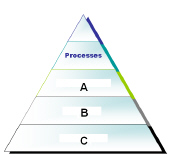Multiple Choice
Identify the
choice that best completes the statement or answers the question.
|
|
|
1.
|
The success of any organization depends upon the performance of each of the
three elements which comprise the organization - identify the option that is not one of those
elements or is of least importance.
a. |
Its products and services |
c. |
Business
processes |
b. |
People |
d. |
Company vision |
|
|
|
2.
|
Which of the following are least likely to be classified as a Cross-functional
process?
a. | New Product Devt | c. | Production Planning | b. | Accounts Receivable | d. | Order
Processing |
|
|
|
3.
|
Continuous improvement should involve three of the items in the list below.
Which item is not typically associated with Continuous improvement?
a. | Intuitive decision making | c. | Identification of possible
solutions | b. | Analysis | d. | Reason for improvement |
|
|
|
4.
|
Which of the following statements about TQM is least true?
a. |
It is a quality approach that emphasises a continuous process of improvement, through
the involvement of people |
b. |
Stress the rigour of statistical process
control to minimize unexplained variation in a process |
c. |
Start from the current state of the process and
chip away at it |
d. |
Begin with a relatively clean slate |
|
|
|
5.
|
When embarking upon a Continuous improvement program Each process should be
evaluated with respect to the items in the list below - which item would not be used to evaluate a
process for the purpose of Continuous improvement?
a. |
Its current performance (particularly in terms of cost) |
b. |
Its potential for
successful change |
c. |
Its relevance to overall strategy or
mission |
d. |
The extent of specialisation required |
|
|
|
6.
|
The ISO 9000 family is primarily concerned with "quality management".
This means what the organization does to fulfil all of the following with the exception of one listed
item below. Identify the item out of place.
a. |
Shareholder needs |
c. |
Achieve continuous improvement |
b. |
The customer's
quality requirements |
d. |
Enhance customer satisfaction |
|
|
|
7.
|
Which managerial innovations was not produced by TQM?
a. |
Quality circles |
c. |
Business process reengineering |
b. |
Cellular
manufacturing |
d. |
Just-in-time
production |
|
|
|
8.
|
American firms began to take serious notice of TQM around
|
|
|
9.
|
TQM may produce value, through a variety of benefits such as (select the least
correct statement)
a. |
Improved customer satisfaction |
b. |
The improved understanding of customers’
needs |
c. |
Improved internal communication |
d. |
Radically reengineered
processes |
|
|
|
10.
|
BPR became vogue in the
a. | 1970’s | c. | 1990’s | b. | 1980’s | d. |
New millennium |
|
|
|
11.
|
 Select the text that best describes the figure
shown a. | Approaches to BPI | c. | Process modelling benefits | b. | Congruence model
| d. | Process
Hierarchy |
|
|
|
12.
|
Which of the following tools and techniques are least likely to be associated
with TQM, BPI or other improvement initiatives?
a. | Cash flow analysis | d. | Cause-and-effect
diagram | b. | Benchmarking | e. | Pareto
diagram | c. | Brainstorming | f. | Flowchart |
|
|
|
13.
|
 Select the item that best defines “X” in the
above figure a. | Raw Materials | c. | Transformational Processes | b. | Strategy | d. | Products |
|
|
|
14.
|
 Consider the Process Hierarchy depicted above. Select
the appropriate label for layer “A” in the hierarchy a. | Tasks | c. | Sub-Processes | b. | Activities | d. | Supra-processes |
|
|
|
15.
|
 Consider the Flowchart
symbols to depict the nature and flow of the steps in a process.
Match the appropriate label
with shape “C” above
a. | Delay | b. |
Decision
point |
c. | An individual step or activity in the
process |
d. | Starting point and the ending point
|
e. |
Document created |
|